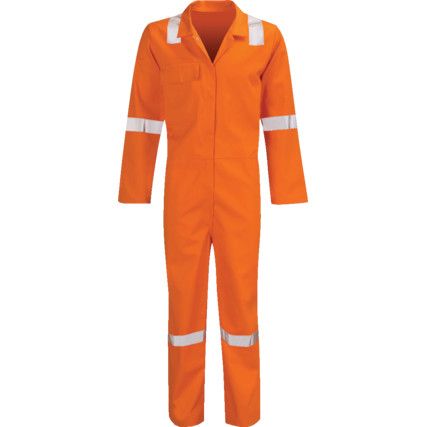ARC Flash & Flame Retardant Coveralls
Protect against the dangers of welding and similar applications with flame retardant overalls and ARC flash coveralls. We stock a wide range of coveralls from market-leading brands, including Portwest®, Pionér®, Dickies®, Mascot® and more.
What are flame retardant overalls & ARC flash coveralls?
Flame retardant and ARC flash coveralls are protective clothing designed for use in welding applications and other similar tasks. Flame retardant or FR coveralls are designed to resist heat and flame, including molten metal spatter and sparks. Their testing involves resistance to flame and self-extinguishing performance.
ARC flash coveralls on the other hand, require much higher levels of protection, as the nature of these applications involve electrical discharge . Class 2 rated materials used to make coveralls have been exposed to an electrical arc and measured on their ability to block that burst of energy.
While some FR coveralls are suitable for use in ARC welding, some are not. To make sure you're wearing the right levels of protection to keep you safe from harm, always check the technical data sheet supplied with the garment. If you're still unsure, ask for advice. Our Experts are available to give valuable advice and guidance when it's needed and can help you to make the right choice.
Why use flame retardant overalls & ARC flash coveralls?
The hazards involved in welding and other, similar applications include second-degree burns and even death. Since the risks of injury are so high, it's of the utmost importance that personal protective clothing is put into place alongside other safety measures.
When are flame retardant overalls & ARC flash coveralls used?
Anyone exposed to open flame, radiant heat or ARC flash must wear appropriate protective clothing. Automotive, mining, oil and gas industries are just a few that contain workers who should be outfitted in FR overalls and ARC flash coveralls.
Flame retardant overalls & ARC flash coverall types
There's a wide choice of FR and ARC flash coveralls to choose from. With different ratings and levels of protection, it's an important decision to get right. We've outlined some useful information below to help you with your purchase.
• Inherent flame retardant coveralls - These are made from synthetic fabrics, which are designed to self-extinguish once the source of the fire is removed. This fabric isn't as comfortable as non-inherent coveralls, however, it's extremely durable and offers consistent protection that isn't diminished through laundering
• Non-inherent flame retardant coveralls - These are made from chemically treated fabric, usually cotton, and are comfortable to wear and cheaper than inherent fabric. However, the protection given by the chemicals can be laundered away over time, and there's no way to identify if the garment still provides the right level of protection
Considerations when choosing flame retardant overalls & ARC flash coveralls
• Protection - depending on the task, determine which kind of protection you'll need. This can be general flame retardant clothing or include protection against electric arc risks.
• Environment - this kind of protective clothing is available in different weights (gm) to suit the kind of environment you work in. The weight of FR coveralls can range from lightweight for extremely high-heat settings to heavier, thermally insulated workwear to ensure comfort in colder environments.
• Type - FR treated cotton coveralls are cheaper and comfortable, while synthetic inherent materials are extremely durable.
• Sizing - start with your chest size and measure different areas, like thighs and leg-length to find a suitable fit. For the more rotund wearer, make sure the coverall waist is approximately 4" larger than your usual trouser size.
• Extras - layers insulate the body and by wearing FR base layers, like long-sleeved t-shirts and long-johns, you provide yourself with layers of protection that will reduce burn injuries and may save your life.
• Class - This is dependent on the kind of welding application being undertaken. Gas welding and soldering for example, fall under Class 1, while MIG, MAG and MMA welding require Class 2 protection.
Flame retardant overalls & ARC flash coveralls jargon buster
Protecting the skin against occupational hazards is an important business. To help you to better understand our FR and ARC flash coveralls, we've broken down and explained an applicable safety standard, so you can make the best choice for you.
What does EN ISO 11611:2015 mean?
This standard outlines the requirements for the protective clothing used for welding and other similar applications. It's designed to ensure the safety of the wearer against risks such as sparks, molten metal splatter and flame.
Let's break it down...
• EN - The translation of the German for European Norm is abbreviated here to signify that this European standard
• ISO - An abbreviation for the International Organization for Standardization, which is the independent governing body for all European quality and safety standards
• 11611 - The legislation number
• 2015 - The year this edition was published, superseding the 2007 version. This version will be replaced with ISO/CD 11611
• Class 1 - This is assigned when the garment passes all the associated tests (including heat transfer, molten metal impact and tensile strength)
• Class 2 - This is assigned when the garment passes the Class 2 requirements in the same tests as Class 1, but with a higher resistance
FAQs
What other clothing should I wear for ARC flash?
Wearing FR clothes underneath an FR coverall, such as long johns, polo shirts, t-shirts and so on, will enhance your protection. Protect your hands with welding gloves and wear a good pair of welding boots.
What kind of injuries are associated with ARC flash?
Injuries from exposure to ARC flash can range from minor to fatal. Nerves can be damaged, restricting movement and sometimes causing permanent pain, vision can be permanently impaired or lost, and serious burns, including third degree burns are a risk.






